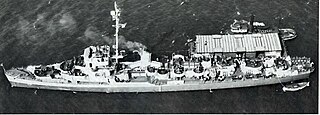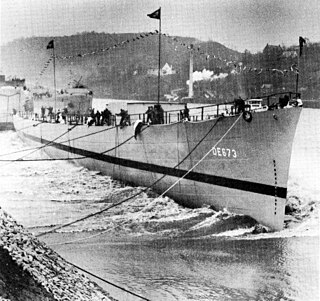
USS Talbot (DD-114) was a Wickes-class destroyer in the United States Navy during World War I and later designated APD-7 in World War II. She was the first ship named in honor of Silas Talbot.

USS Schmitt (DE-676) was a Buckley-class destroyer escort in the United States Navy, commissioned in 1943. In late 1944, she was converted to a high speed transport and was redesignated APD-76. She was retired in 1949 and transferred to the Republic of China Navy in 1969, where she served as ROCS Lung Shan (PF-44) until 1976, when she was scrapped.

USS Gosselin (APD-126) was a Crosley-class high speed transport of the United States Navy, in service from 1944 to 1949. She was sold for scrap in 1965.

USS Gantner (DE-60/APD-42), a Buckley-class destroyer escort of the United States Navy, was named in honor of Boatswain's Mate Samuel Merritt Gantner (1919-1941), who was killed in action during the Japanese attack on the Hawaiian Islands.

USS Ira Jeffery (DE-63/APD-44), a Buckley-class destroyer escort of the United States Navy, was named in honor of Ensign Ira Weil Jeffery (1918–1941) who was killed in action during the Japanese attack on the Hawaiian Islands while serving aboard the battleship California.

USS Amesbury (DE-66/APD-46), a Buckley-class destroyer escort of the United States Navy, was named in honor of Lieutenant (jg) Stanton Morgan Amesbury (1916–1942), who was killed in action while flying from the aircraft carrier Ranger (CV-4) during Operation Torch in 1942.

USS Hopping (DE-155) was a Buckley-class destroyer escort in service with the United States Navy from 1943 to 1947. In 1944, she was converted to a Charles Lawrence-class high speed transport and redesignated "APD-51". She was sold for scrap in 1966.

USS Reeves (DE-156/APD-52) was a Buckley-class destroyer escort in service with the United States Navy from 1943 to 1946. She was transferred to Ecuador for use as an electric generator plant in 1960. Her final fate is unknown.

USS Lloyd (DE-209/APD-63), a Buckley-class destroyer escort of the United States Navy, was named in honor of Ensign William R. Lloyd (1916–1942).

USS Burke (DE-215/APD-65), a Buckley-class destroyer escort of the United States Navy, was named in honor of Lieutenant Commander John E. Burke (1905–1942), who was killed in action, aboard the battleship South Dakota during the Naval Battle of Guadalcanal on 15 November 1942.

USS Bowers (DE-637/APD-40) was a Buckley-class destroyer escort of the United States Navy, was named in honor of Ensign Robert K. Bowers (1915-1941), who was killed in action aboard the battleship USS California during the Japanese attack on Pearl Harbor on 7 December 1941. The ship was laid down on 28 May 1943 at San Francisco, California, by the Bethlehem Steel Company; launched on 31 October, sponsored by Mrs. Eunice Bowers, the mother of Ensign Bowers; and commissioned on 27 January 1944. The ship served in World War II in the Pacific

USS William C. Miller (DE-259) was an Evarts-class destroyer escort constructed for the United States Navy during World War II. She was sent off into the Pacific Ocean to protect convoys and other ships from Japanese submarines and fighter aircraft. She performed escort and anti-submarine operations in dangerous battle areas and returned home with seven battle stars, a very high number for a ship of her type.

USS Register (APD-92), ex-DE-233, was a United States Navy high-speed transport in commission from 1945 to 1946.

USS Brock (APD-93), ex-DE-234, was a United States Navy high-speed transport in commission from 1945 to 1947.

USS John Q. Roberts (APD-94), ex-DE-235, was a United States Navy high-speed transport in commission from 1945 to 1946.

USS Knudson (APD-101), ex-DE-591, later LPR-101, was a United States Navy high-speed transport in commission from 1944 to 1946 and from 1953 to 1958.

USS Rednour (APD-102) was a Crosley-class high speed transport that served in the United States Navy from 1945 to 1946. In December 1969, she was transferred to Mexico and served as Chihuahua until July 2001.

USS William J. Pattison (APD-104), ex-DE-594, was a United States Navy high-speed transport in commission from 1945 to 1946.

USS John P. Gray (APD-74), ex-DE-673, was a United States Navy high-speed transport in commission from 1944 to 1946.

USS Yokes (APD-69), ex-DE-668, was a United States Navy high-speed transport in commission from 1944 to 1946.




















